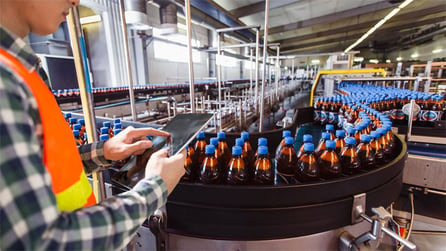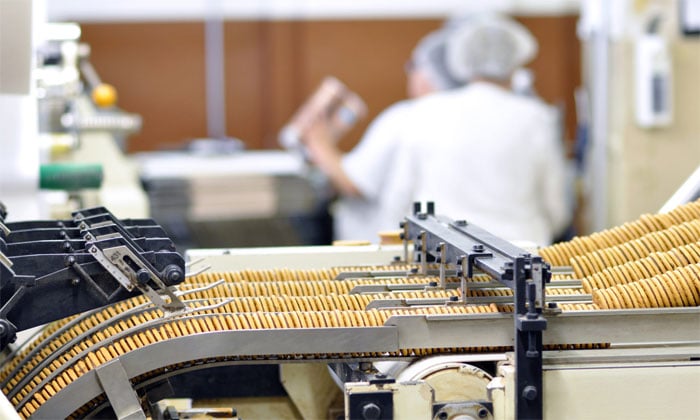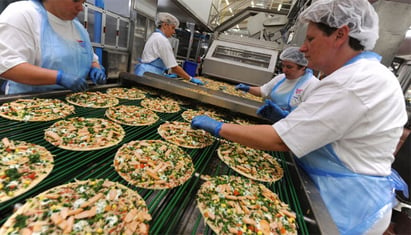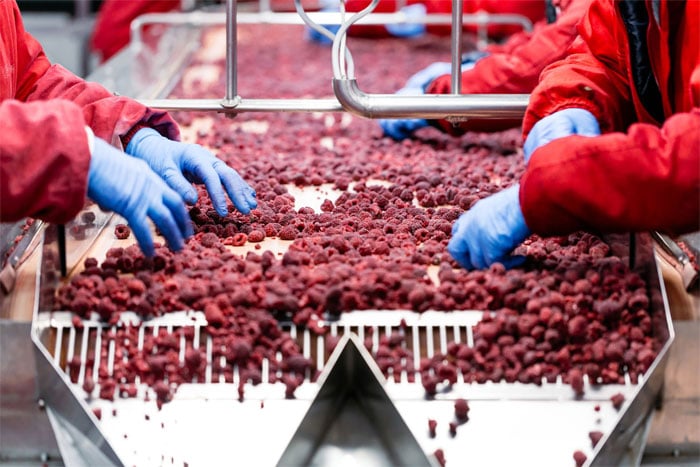Entering the post-COVID-19-era requires us to learn new habits, rethink old ways, and adjust to a lifestyle different than years prior – especially in the business landscape. No matter your place within the supply chain, you can feel the pandemic’s rippling effects on costs, imports, and overall business profitability.
Zooming into the food and beverage industry, costs and taxes are skyrocketing as goods move from production to consumer. These increases tighten margins and make it more and more difficult to satisfy consumer’s needs and standards while still maintaining a profitable business in the industry. In an effort to mitigate these losses, companies have been passing these higher input costs to consumers by increasing the ticket price.
Though this may be fiscally savvy, smaller food and beverage companies may not be able to maintain a competitive edge while growing their customer base using this strategy. According to Mazars USA industry outlook, companies’ top concerns include the need to increase sales without sacrificing customer profitability (https://www.fooddive.com/news/rising-costs-a-top-concern-of-food-and-beverage-leaders-survey-finds/603268/). So how can you find the right balance between customer satisfaction and calculated business decisions?
Utilizing Order Time’s automated inventory management system gives you the insights you need to balance the ebbs and flows of the ever-changing industry. Understand how your inventory is fluctuating, price adjustments to compensate, and track the entire production process all from our cloud-based system. Here are just a few of our many tools and integrations to help the food and beverage industry find that perfect balance.
Inventory Primer
As input costs and taxes increase in your business, it is crucial to have an accurate understanding of where your current inventory lies, if and how it needs to grow, and how to plan for future business. Order Time’s vast assortment of inventory tools give you the control you need to make smart business decisions, locate inventory at any time anywhere, and streamline the workflow.
Our inventory primer is an essential tool used to value inventory to protect against major issues down the line that impact the P&L, balance sheet, and taxes. These are intertwined, each having a determining factor in cost of sales and profits with an inverse relationship. Say after valuation you find you have a low inventory. This generates a higher cost of sales, leading to a lower profit for your business. The opposite would occur if you had a higher inventory valuation.
The industry rule of thumb is that inventory should be valued at the lower of the cost and the market value. Before diving into inventory valuation, be sure to understand the costs included that drive your bottom line. Your cost of inventory is the sum of purchasing the inventory itself as well as all the fees to make it available for sale, such as duty, freight, overhead, and more. 
It is crucial to note that there are three inventory valuation methods you can employ to ensure you can have an accurate grasp of your standings. The most used method is FIFO. FIFO, or first-in-first-out, assumes that inventory is sold in the order it is manufactured, representing the actual flow of goods in the business. On the other hand, LIFO, or last-in-first-out, assumes the opposite of FIFO – the most recently manufactured goods are sold first. Using weighted average cost, or WAC, inventory and cost of goods sold are based on the average cost of all purchased items within a period.
How do you know which valuation method is right for your business? During these times of rising costs, FIFO would result in the highest inventory valuation and gross profit. Being the exact opposite, LIFO would determine higher valuation and profit as costs fall. WAC estimates FIFO and may also be used if your business’ inventory does not include a lot of variation.
To learn more about inventory valuation, adjustments, and how Order Time can assist in controlling your business’ inventory click here.
Inventory Valuation and Ledgers
As we mentioned, inventory valuation is the first step in finding the balance between mitigating financial losses while simultaneously satisfying and growing your customer base. Once you gain an understanding of your food and beverage business’ standings, the challenging part is transforming the data into actionable opportunities. One of Order Time’s biggest benefits to your business is its vast assortment of reporting capabilities to assist in this process.
 Our inventory status, valuation, and velocity reports are here to guide in making better business decisions down the line without the headache of time consuming and error-prone manual methods. Using historical sales data and trend forecasting, Order Time can give you the details needed for success. We use Tabular reports to give a detailed rundown of your data, Summary reports for stand-alone details and a business overview, and Pivot reports that processing counts, averages, and sums. Be sure to watch our Webinar for additional details.
Our inventory status, valuation, and velocity reports are here to guide in making better business decisions down the line without the headache of time consuming and error-prone manual methods. Using historical sales data and trend forecasting, Order Time can give you the details needed for success. We use Tabular reports to give a detailed rundown of your data, Summary reports for stand-alone details and a business overview, and Pivot reports that processing counts, averages, and sums. Be sure to watch our Webinar for additional details.
For an insightful view on your inventory value and movement, our Ledger Reports are a great asset to your business. View all item transactions on a quarterly basis, receivers adding inventory value, and monitor ship docs as they remove inventory. You can automatically drill down your data on an individual SKU level, monitor all sales, and track changes as business flows within one easy-to-use platform. For more information and a tutorial on ledger reports and valuation reports, watch this Webinar.
Pricing and Price Levels
Rising prices throughout the supply chain found their way to customers as the cost in inputs, imports, and transportation reached all-time highs. While balancing these increases can seem like a daunting task, Order Time can assist in establishing and tracking all markups and discounts throughout your business, including company, item, and customer price levels.
Company price levels are applied to all items and customers. Company Wide price levels apply a specific discount price once all other price levels have been applied to a good. If purchasing internationally or looking to keep prices in line with local markets, setting a Currency Price allows you to apply a discount or markup to individual items purchased in a different currency. For increased flexibility, you can set a Customer Item by Percentage price level to give a specific customer a percentage-based markup or markdown.
Item price levels can be applied to items within your inventory, such as item markups and volume discounts by price. Applying an Item Markup adds a percentage to the cost of specific goods, while a Volume Discount by price is applied to a subset of an item. Volume discounts specify quantity minimum and maximums to discount all items that fall within the range.
Lastly, price levels may be assigned to customers, known as customer price levels. Customer Discounts and Markups give a specific customer a reduced price or markup percentage to the price after all item level price levels are assigned. Customer Item Price gives you more flexibility to set a specific price for each item for a particular customer. To give a percentage discount per item on a group basis, use the Customer Item Group Discount price level. If you are looking to bundle many customer-specific price levels into a singular applicable price level, the Customer Pricing Group price level can be used. Customer Stacked Percentages are used to reach a final price by combining multiple price levels such as combined discounts.
For additional resources, we recommend reading these articles on types of price levels, adding them to your business, or watch our Webinar on price levels and discounts.
Manufacturing Made Simple
If your business has a manufacturing or production-based role in the food and beverage supply chain, Order Time features the tools needed to ensure a seamless workflow and optimize profits. With the click of a button Order Time gives insight into your stock levels, lots and batches, work order processing, and more as exemplified in our Webinar.
To make the best pricing decisions for your business, you need to have a precise grasp on your cost to complete goods. Create a Bill of Materials, or BOM, in minutes by telling the system which components you need to make the finished goods for your customers. Our system will take this information to calculate real-time inventory levels for each component, identify low levels, and reorder necessities to keep production running without a hinge.
For heightened accuracy into your input costs, manufacturers can add labor costs into their BOM, including direct and indirect costs. Examples of direct costs include subcontractors, direct labor, and materials, while overhead is a prime example of an indirect cost. These costs are Capitalized, meaning they are added to the inventory asset account and cost of goods sold when the goods are purchased as opposed to being recognized as an expense.
The BOM will automate the sum of your standard cost of components for you to ease the entire process. Using item groups, our system categorizes items and pro-defines properties such as Type, Unit of Measure, and Accounts. Item Cost Type is used to determine how a particular group defines the cost of items, including factors such as purchase price, default vendor’s cost, and the sum BOM cost. The Unit of Measure defines how quantities are stocked and any associated conversion rates for users, customers, and vendors. Account settings are used to define how the Group’s items are accounted for in your General Ledger Accounts. 
For additional customization, you can design your BOM to cater specific needs and business processes. If your business produces the entire assembly at one, a regular Bill of Materials may be enough. This method simply entails one BOM that includes all sub-assemblies and steps to outline them. However, we recommend utilizing a Nested Bill of Materials for production processes that involve sub-assemblies throughout production to be later combined into the finished good.
Order Time’s manufacturing features are endless and cater to all your needs in one centralized location. Learn more about tracking work orders, monitoring production levels, raw material usage, scheduling, and more by clicking here.
What Now?
As the industry continues to change and evolve, the competitive landscape within the food and beverage industry becomes increasingly larger. Order Time’s automated inventory platform can give you the edge you need to transform raw materials into profits and happy, returning customers. Learn more about our features and integrations to assist each step of the way.
Love everything you’ve read? Order Time offers all types of advantages for your sales team!
Sign up for a one-on-one meeting to get all your questions and concerns answered, or check out our detailed video tutorials and knowledge base. Order Time is constantly updating, so check out the latest release notes.
Feel free to call our sales representatives, 1-866-278-6243, dial 1 for Sales or visit our website for more details!
We're always adding new Features, so if you have one you can't live without, let us know using the Contact Us Form.For more information check out our Order Time Cheat Sheet.
|
Looking into using QuickBooks Online, want a discount? Click here!
Find out why it's time to migrate into the cloud.
Follow us!















